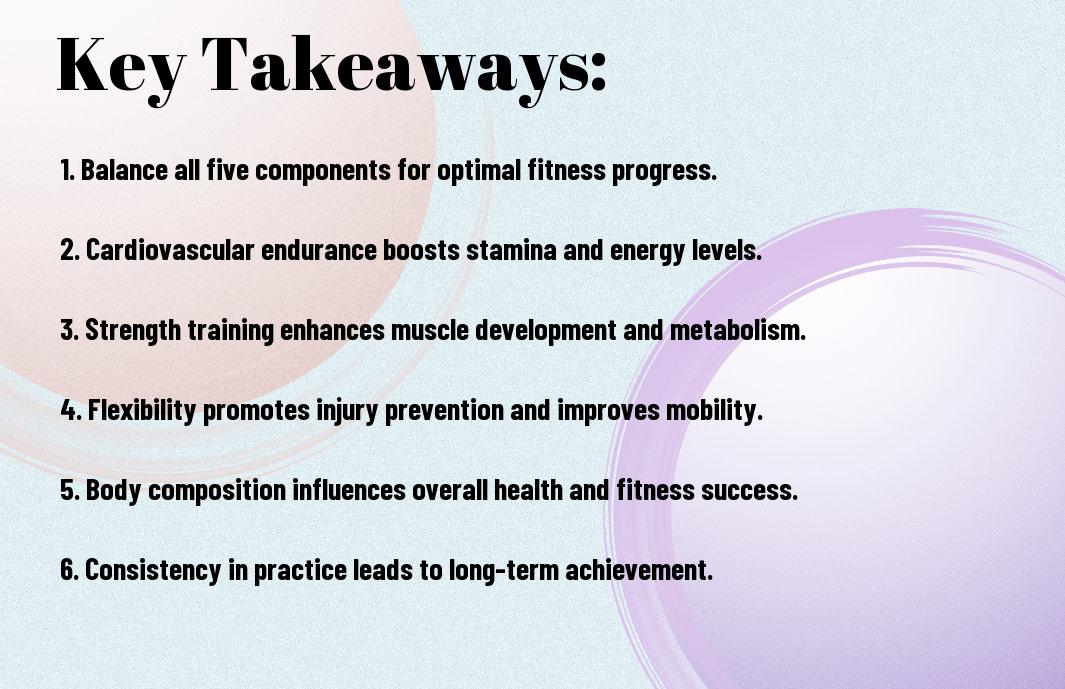Many people overlook the significance of incorporating all five components of fitness into their exercise regimen. By understanding and applying these components — muscular strength, muscular endurance, flexibility, cardio-respiratory endurance, and body composition — you can effectively enhance your physical performance and overall health. A balanced approach to fitness not only helps you avoid injuries but also enables you to achieve your fitness goals more efficiently. In this blog post, we will explore each component and how you can integrate them into your daily routine for optimal results.

Key Takeaways:
- Cardiovascular Endurance: Enhances heart and lung efficiency, allowing for longer and more effective workouts.
- Muscular Strength: Builds muscle power, which is necessary for daily activities and boosts metabolism.
- Muscular Endurance: Increases the ability to perform sustained physical activity without fatigue.
- Flexibility: Improves range of motion and reduces the risk of injuries, promoting overall physical health.
- Body Composition: Balances fat and lean mass, leading to a healthier body and improved confidence.

Understanding the 5 Components of Fitness
Achieving your fitness goals requires a well-rounded approach that incorporates the 5 components of fitness: cardiovascular endurance, muscular strength, muscular endurance, flexibility, and body composition. Each component plays a vital role in enhancing your overall health and performance. By understanding and integrating these elements into your fitness routine, you will be better equipped to reach your personal goals and maintain a healthy lifestyle.
Cardiovascular Endurance
Along with strength training, having strong cardiovascular endurance is imperative for overall fitness. It reflects your heart and lung efficiency during physical activities, allowing you to perform at your best for longer periods. Improving cardiovascular endurance can boost your stamina and energy levels, enhancing your ability to engage in daily tasks and workouts.
Muscular Strength
Understanding muscular strength is key to developing a routine that supports your fitness ambitions. It refers to the maximum amount of force your muscles can exert during a single effort, which is vital for lifting heavy objects and performing everyday tasks effectively.
Fitness involves incorporating routines that target your major muscle groups for optimal strength development. This can include resistance training and weightlifting, which challenge your muscles to adapt and grow stronger. By progressively increasing the weight you lift or the resistance you use, you can significantly enhance your muscular strength, improving your functional abilities and overall performance in sports and physical activities.
Muscular Endurance
About muscular endurance, this component measures how well your muscles can perform repeated contractions over an extended period without fatigue. Increasing your muscular endurance enables you to engage in physical activities for longer durations without tiring easily.
To improve your muscular endurance, you should focus on incorporating exercises with lighter weights and higher repetitions into your routine. Activities such as circuit training or bodyweight exercises can help build this endurance, ensuring that your muscles can sustain prolonged efforts, whether it’s during sports or daily tasks such as climbing stairs or lifting groceries.
Flexibility
One important aspect of your fitness journey is flexibility, which refers to the range of motion in your joints and muscles. Being flexible helps prevent injuries, improve posture, and enhance overall performance during physical activities.
At its core, flexibility allows your body to move more freely and efficiently. Regular stretching and flexibility exercises can significantly benefit your fitness routine. Engaging in yoga or dedicated stretching sessions can increase your muscular elasticity, leading to better movement patterns and reduced risk of strain during other workouts.
Body Composition
Muscular strength and endurance contribute to achieving a healthy body composition by affecting your muscle-to-fat ratio. This balance plays a critical role in your overall health and wellbeing.
For instance, focusing on both your muscle mass and fat percentage can lead to a more toned and energetic physique. Regularly tracking your body composition can provide insights into your progress, helping you make informed adjustments to your diet and exercise regimen for optimal results. Understanding this component of fitness empowers you to work towards a healthier, balanced body.
The Role of Cardiovascular Endurance in Goal Achievement
After integrating cardiovascular endurance into your fitness routine, you may notice improved energy levels and stamina that directly support your goal achievement. With a stronger heart and lungs, your body becomes more efficient at using oxygen, allowing you to perform activities longer and with less fatigue. This enhanced fitness not only boosts your productivity in workouts but also positively impacts your daily life, making everyday tasks seem easier. Neglecting this component, on the other hand, can lead to fatigue and decreased performance, hindering your progress and overall well-being. Embrace cardiovascular endurance to ensure you reach your potential.
Building Strength: The Foundation of Fitness
For your fitness journey, building strength is vital as it enhances your overall performance and helps you prevent injuries. By incorporating strength training into your routine, you are not only increasing your muscle mass but also improving bone density and boosting your metabolism. Aim to target all major muscle groups at least twice a week; this will lead to improved functional abilities in daily tasks and activities. It’s important to progressively challenge yourself with weights to see continuous gains and avoid plateauing, ensuring that you’re always making progress toward your goals.

Enhancing Muscular Endurance for Sustained Performance
Once again, you can take your fitness to the next level by enhancing muscular endurance, which is imperative for prolonged physical activities. This component allows you to perform repetitive movements with less fatigue, significantly improving your overall performance during workouts or sports. Incorporating exercises like high-rep weight training and circuit training will increase your stamina, ensuring you can push through those last few sets. Additionally, focusing on proper nutrition and hydration plays a vital role in maintaining your energy levels. By prioritizing muscular endurance, you’re setting yourself up for long-term success in achieving your fitness goals.
Flexibility: A Key to Injury Prevention and Performance
Despite your best efforts in strength training and cardio, neglecting flexibility can lead to injuries that sideline your progress. Incorporating flexibility exercises into your routine not only enhances your range of motion but also improves your overall performance in various physical activities. Regular stretching can reduce muscle stiffness and help maintain proper alignment, making it easier for you to execute movements efficiently. By prioritizing flexibility, you are investing in your body’s resilience, ultimately allowing you to stay active and achieve your fitness goals.
Body Composition: Finding the Right Balance for Success
Not only does your body composition affect your physical appearance, but it also plays a significant role in your overall health and fitness performance. Achieving the right balance of fat and lean mass can enhance your longevity and support your active lifestyle. To guide you in optimizing your body composition, consider reviewing the 1 EXERCISE GUIDELINES A. Health-related components …, which highlights the importance of a well-rounded exercise routine. By prioritizing a balanced body composition, you can reduce risks of chronic diseases and improve your energy levels and performance, ultimately leading you to success in your fitness journey.
Conclusion
Ultimately, integrating the five components of fitness—cardiovascular endurance, muscular strength, muscular endurance, flexibility, and body composition—into your routine is necessary for achieving your goals. By understanding each component’s significance, you can tailor your workouts to enhance performance across various activities and improve overall health. Prioritizing these elements not only helps you reach your objectives more effectively but also contributes to a balanced and sustainable fitness journey that supports your lifestyle and well-being.
FAQ
Q: What are the five components of fitness?
A: The five components of fitness are cardiovascular endurance, muscular strength, muscular endurance, flexibility, and body composition. Each component plays a vital role in overall health and physical performance. Cardiovascular endurance relates to the efficiency of the heart and lungs, muscular strength is the amount of force a muscle can produce, muscular endurance refers to the ability of a muscle to perform repeated actions, flexibility is the range of motion of joints, and body composition describes the proportion of fat to lean mass in the body.
Q: How can I incorporate all five components of fitness into my routine?
A: To include all five components in your fitness regimen, consider a balanced routine that includes aerobic exercises (like running, cycling, or swimming) for cardiovascular endurance, strength training (such as weight lifting or resistance bands) to build muscular strength, high-repetition bodyweight exercises (like push-ups or squats) for muscular endurance, stretching or yoga for flexibility, and regular assessments of your body composition. Aim for a mix of activities throughout the week that address each component without overwhelming yourself.
Q: Why is flexibility considered one of the components of fitness?
A: Flexibility is an important component of fitness as it allows the body to move freely and efficiently. Adequate flexibility can enhance your physical performance in sports and daily activities while helping to prevent injuries. Including flexibility training, such as stretching and yoga, can improve the range of motion in joints, decrease muscle tension, and promote better overall posture.
Q: How do the components of fitness contribute to achieving my health and fitness goals?
A: The five components of fitness work together to enhance your overall health and performance. By developing cardiovascular endurance, you improve heart and lung functions, which can increase your energy levels for daily activities. Muscular strength and endurance contribute to better performance in sports and help with daily tasks. Flexibility allows for better movement patterns and can reduce the risk of injury. Lastly, maintaining a healthy body composition is key in managing weight and improving self-confidence. Together, these components support a balanced approach to fitness, aiding in the achievement of your health and performance goals.
Q: How can I measure improvements in each component of fitness?
A: Measuring improvements in the components of fitness can be done through various tests and assessments. For cardiovascular endurance, you might use a timed run or a VO2 max test. Muscular strength can be assessed by the maximum weight you can lift for one repetition (1-RM) in exercises like the bench press or squat. To evaluate muscular endurance, you could perform maximum repetitions of bodyweight exercises in a set timeframe. Flexibility can be measured using tests like the sit-and-reach test. Body composition can be assessed through methods like skinfold measurements or bioelectrical impedance analysis. Regular assessments allow you to track progress and adjust your fitness plan as needed.



